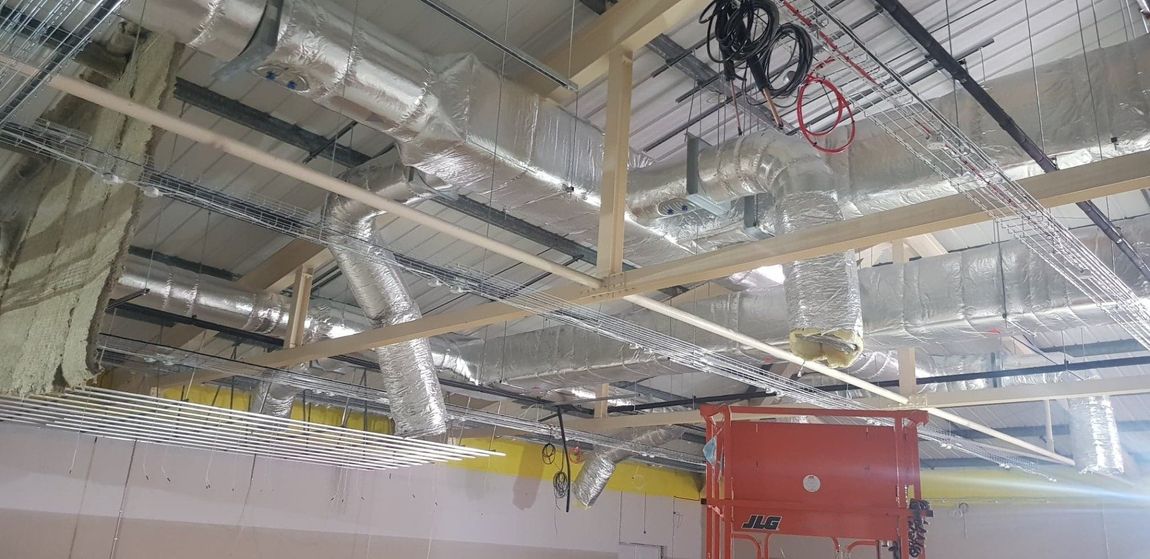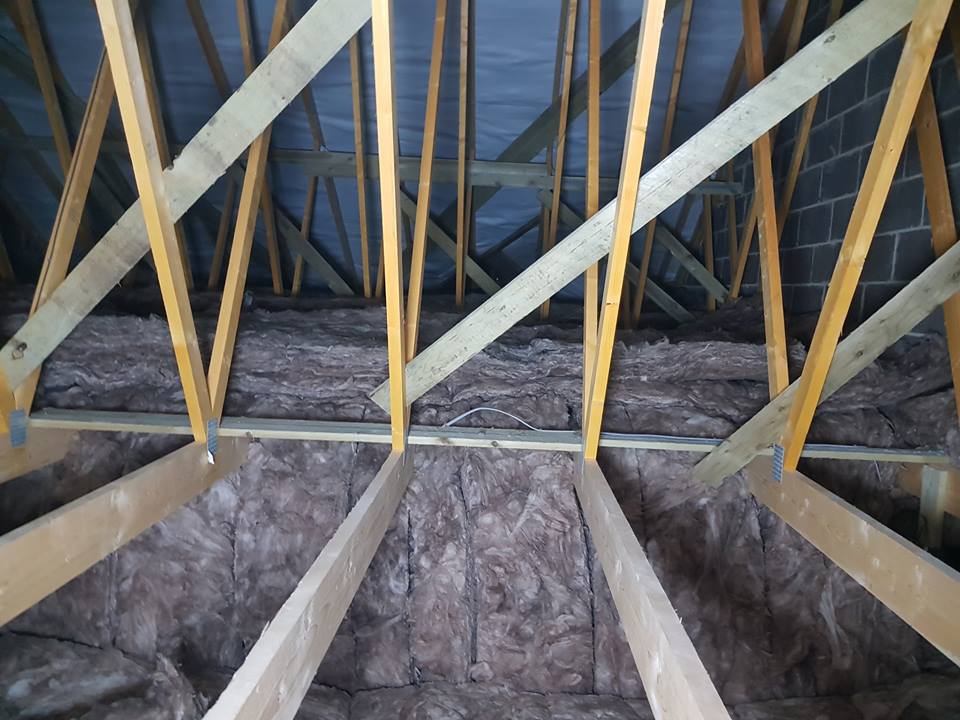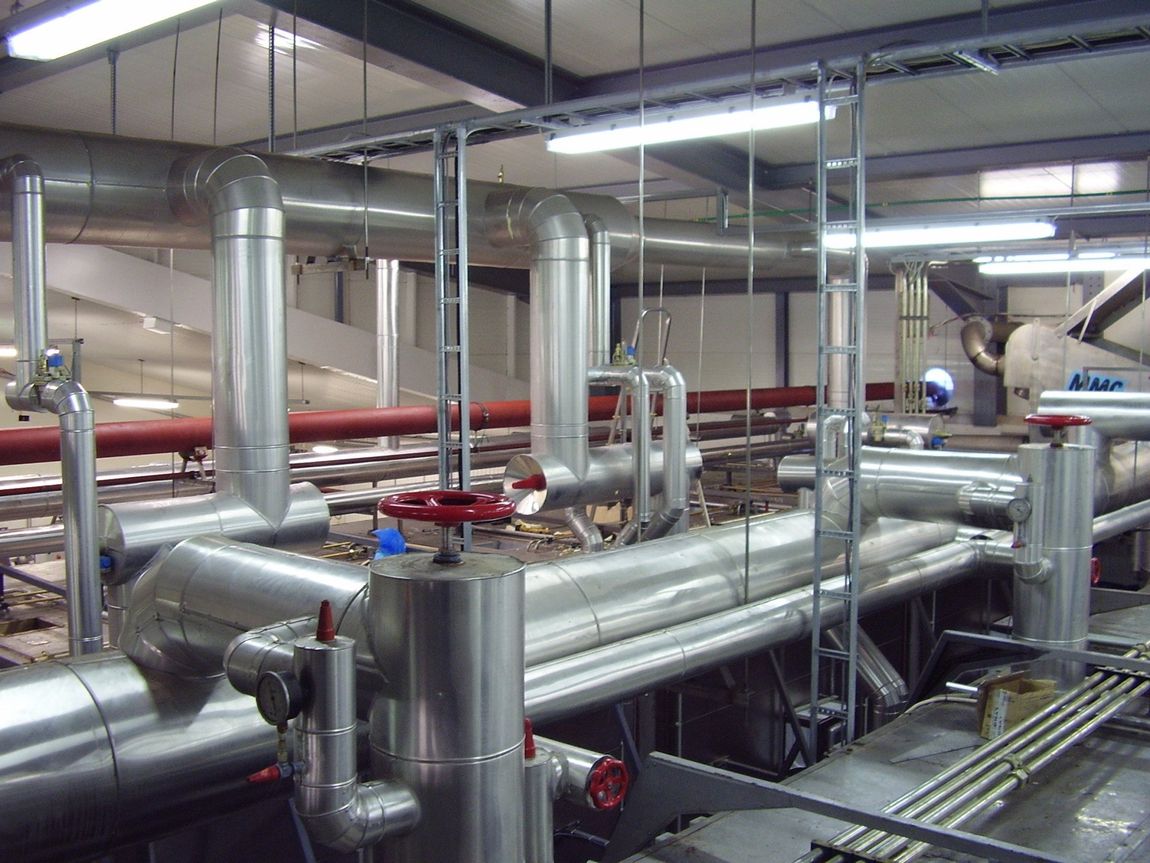SERVICES

PIPE INSULATION
Condensation control
Where pipes operate at below-ambient temperatures, the potential exists for water vapour to condense on the pipe surface. Moisture is known to contribute towards many different types of corrosion, so preventing the formation of condensation on pipework is usually considered important.
Pipe insulation can prevent condensation forming, as the surface temperature of the insulation will vary from the surface temperature of the pipe. Condensation will not occur, provided that (a) the insulation surface is above the dewpoint temperature of the air; and (b) the insulation incorporates some form of water-vapour barrier or retarder that prevents water vapour from passing through the insulation to form on the pipe surface.
Pipe freezing
Since some water pipes are located either outside or in unheated areas where the ambient temperature may occasionally drop below the freezing point of water, any water in the pipework may potentially freeze. When water freezes it expands and this expansion can cause failure of a pipe system in any one of a number of ways.
Pipe insulation cannot prevent the freezing of standing water in pipework, but it can increase the time required for freezing to occur—thereby reducing the risk of the water in the pipes freezing. For this reason, it is recommended to insulate pipework at risk of freezing, and local water-supply regulations may require pipe insulation be applied to pipework to reduce the risk of pipe freezing.[1]
For a given length, a smaller-bore pipe holds a smaller volume of water than a larger-bore pipe, and therefore water in a smaller-bore pipe will freeze more easily (and more quickly) than water in a larger-bore pipe (presuming equivalent environments). Since smaller-bore pipes present a greater risk of freezing, insulation is typically used in combination with alternative methods of freeze prevention (e.g., modulating trace heating cable, or ensuring a consistent flow of water through the pipe).
Energy saving
Since pipework can operate at temperatures far removed from the ambient temperature, and the rate of heat flow from a pipe is related to the temperature differential between the pipe and the surrounding ambient air, heat flow from pipework can be considerable. In many situations, this heat flow is undesirable. The application of thermal pipe insulation introduces thermal resistance and reduces the heat flow.
Thicknesses of thermal pipe insulation used for saving energy vary, but as a general rule, pipes operating at more-extreme temperatures exhibit a greater heat flow and larger thicknesses are applied due to the greater potential savings.[2]
The location of pipework also influences the selection of insulation thickness. For instance, in some circumstances, heating pipework within a well-insulated building might not require insulation, as the heat that's "lost" (i.e., the heat that flows from the pipe to the surrounding air) may be considered “useful” for heating the building, as such "lost" heat would be effectively trapped by the structural insulation anyway.[3] Conversely, such pipework may be insulated to prevent overheating or unnecessary cooling in the rooms through which it passes.
Protection against extreme temperatures
Where pipework is operating at extremely high or low temperatures, the potential exists for injury to occur should any person come into physical contact with the pipe surface. The threshold for human pain varies, but several international standards set recommended touch temperature limits.
Since the surface temperature of insulation varies from the temperature of the pipe surface, typically such that the insulation surface has a "less extreme" temperature, pipe insulation can be used to bring surface touch temperatures into a safe range.
Control of noise
Pipework can operate as a conduit for noise to travel from one part of a building to another (a typical example of this can be seen with waste-water pipework routed within a building). Acoustic insulation can prevent this noise transfer by acting to damp the pipe wall and performing an acoustic decoupling function wherever the pipe passes through a fixed wall or floor and wherever the pipe is mechanically fixed.
Pipework can also radiate mechanical noise. In such circumstances, the breakout of noise from the pipe wall can be achieved by acoustic insulation incorporating a high-density sound barrier.

DUCT INSULATION
Mineral wool (fiberglass)
Ductwrap is a lightweight and flexible insulation roll faced with reinforced aluminium foil.
Ductwrap is ideal for both circular and rectangular ductwork. This solution is recommended for service temperatures of up to 230˚C. The thermal insulation solutions are often applied to air conditioning, warm air and extractor ducts, located in plant rooms, boiler houses or externally.
In addition to its thermal properties, the mineral wool insulation delivers acoustic performance which can be desirable for applications to ducts that carry gases, fluids or particle solids at high velocities. The use of ductwrap can also significantly improve the level of environmental sound, for a far more pleasant working environment.
Closed cell (phenolic)
Duct Insulation comprises a fiber-free rigid thermostat phenolic insulation core, faced on one side (external face) with an aluminium vapour barrier foil, and faced on the other side (internal face) with a glass tissue based facing. Both facings are autohesively bonded to the insulation core during manufacture.
Duct Insulation has a 90% (or greater) closed cell structure and a compressive strength that typically exceeds 100 kPa at 10% compression. Solutions are available to accommodate the surface curvature of circular and flat oval ductwork with an outside diameter (O.D.) of 80 mm or greater.

LOFT INSULATION
Loft insulation is a barrier of material within your roof space. It can either be laid between the joists (the horizontal beams along the floor of your attic) or the rafters (the angled beams that support the roof).
Either way, it slows down the transfer of heat between your living space and the outside world, creating a warmer home in winter and a cooler one in summer. Insulation between the joists keeps warmth in your living space below and creates a cold loft, while insulation in the rafters allows you to keep warmth in the roof space as well.
Other benefits of roof insulation include:
Lower heating bills.
Reducing your home’s carbon footprint.
Improving its energy efficiency rating.
Increasing your home’s value.

CLADDING
Insulation jacketing consists of an outer covering that is wrapped around tubing or pipe insulation to protect the insulation from moisture, wear and mechanical damage. The jacket also serves to provide support for the insulation and establish the system emissivity and appearance. Insulation jacketing plays an important role in the efficiency of the insulation.
The type of jacketing used depends on the mechanical, chemical, thermal, and moisture conditions of the installation as well as cost and aesthetics requirements.
Types
Insulation jacketing can be broken into five functional groups.
Weather barriers
Vapor retarders
Mechanical abuse coverings
Appearance coverings
Hygienic coverings
GET A QUOTE
Skye Insulation has been in the business of saving homeowners and businesses from high energy bills and unwanted heat loss since 2017.
Call us now on 07415 066458
